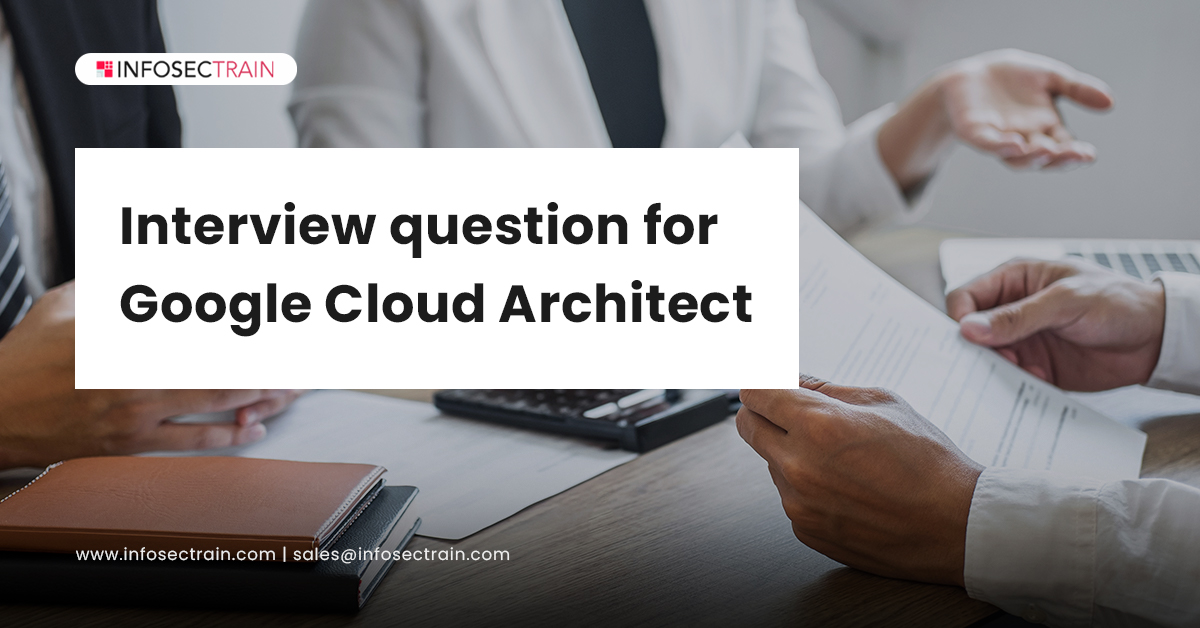Frequently Asked Questions in a Google Certified Cloud Architect Interview

Cloud computing has grown in importance as technology advances and becomes a more integral part of our daily lives. There are many cloud providers to choose from like AWS, Microsoft Azure, GCP, and more. However, Google Cloud Platform (GCP) is a widely used cloud computing platform for several reasons, such as its convenient, easy-to-use tools and services. This increased use of GCP increases the demand for professionals who can operate in GCP. One such professional is a Cloud Architect. A Cloud Architect is critical in the development of an organization’s computing strategy. A Cloud Architect’s primary responsibility is to provide development teams with cloud infrastructure expertise. They manage cloud environments and provide expert guidance to development teams in an organization, armed with a thorough understanding of cloud concepts, networking, and security. So here are frequently asked questions in a Google Certified Cloud Architect interview questions and answers:
Question 1: Name some cloud service provider companies.
Answer: For Business-to-business data analytics, AI, and more, here are some of the best and fastest-growing cloud service providers:
- Amazon Web Services
- Google Cloud Platform
- Microsoft Azure
- IBM Cloud
- Snowflake
- Salesforce
- DataRobot
- Oracle Cloud
Question 2: How can you speed up large data transfers on the cloud?
Answer: The hybrid transfer protocol, also known as Accelerated File Transfer Protocol (AFTP), is one of the best methods for transferring large data files to the cloud. This protocol is a TCP/UDP hybrid that can increase file transfer speeds by 100%. Furthermore, poor network conditions can sometimes prevent you from fully exploiting the potential of big data cloud computing. One of the best ways to deal with this issue is to avoid using the internet for file transfers entirely and ship portable storage devices containing data to cloud service providers.
Question 3: Discuss the strategy for cloud application migration.
Answer: The degree of difficulty in migrating current applications varies depending on the architecture and existing licensing arrangements. Some of the most important cloud migration strategies are:
- Detailing the company’s goals using the cloud
- Recruiting the best professionals
- Conducting a thorough business and technical analysis of the current environment, applications, and infrastructure
- Choosing cloud distributors
- Developing a cloud framework
- Using migration models such as Lift and Shift (Rehost) and Rearchitect (Refactor) to make your application cloud-ready
- Creating a data migration strategy
Question 4: What is the importance of API gateway?
Answer: An API gateway is a tool for managing APIs between clients and a collection of backend services. The API gateway acts as a reverse proxy, accepting all application programming interface calls, aggregating the various services required to fulfill them, and returning accurate results. API gateways are a method of decoupling the client interface from the server-side execution. When a client makes a request, the API gateway divides it into multiple requests, paths them to the appropriate locations, generates a response, and records everything.
Question 5: Why do you utilize subnets?
Answer: A subnet, also known as a subnetwork, is a segmented section of a more extensive network. Subnets are a logical division of an IP network into multiple, smaller network segments, and organizations use them to divide larger networks into smaller, more efficient subnetworks. A subnet’s primary goal is to divide a large network into a collection of smaller, interconnected networks to reduce traffic. This eliminates the need for traffic to take unnecessary routes, resulting in faster network speeds.
Question 6: Mention some cloud security best practices.
Answer: Cloud services are used for various purposes in corporate environments, from storing data to accessing productivity tools. Here are some of the most effective cloud security methods:
- Concentrate on assessing risk and gaining a better understanding of your current situation
- Protect your cloud services strategically based on the level of risk
- As new services emerge, adjust your cloud access policies
- Remove malware from a cloud service
Question 7: In the cloud, what and how many different types of deployment models are used?
Answer: The various cloud computing deployment models are as follows:
- Public cloud
- Private cloud
- Community cloud
- Hybrid cloud
Question 8: What exactly is Google Cloud Platform?
Answer: The Google Cloud Platform was created by Google. It makes its cloud systems and computing services available to the public. GCP offers computing, storage, big data, machine learning, and application services for your web, mobile, analytics, and backend solutions. It is both global and cost-effective. It is designed to use for security purposes.
Question 9: What are the benefits of utility computing for a user?
Answer: Utility computing is a type of pay-as-you-go and on-demand computing service. The provider manages and operates the computing services, and you choose which ones to use, all of which are hosted in the cloud.
Question 10: How do you ensure data is secure when you’re transferring it?
Answer: To ensure that the data being transmitted is secure, make sure data is encrypted and then check the encryption key that has been implemented and that the data has not been leaked.
Question 11: What security features does the cloud provide?
Answer: The following are some of the important security features that the cloud provides:
Identity management: It allows the application services to be authorized.
Access control: It allows users to control who has access to other users in the cloud ecosystem.
Authentication and authorization: This security feature restricts only authenticated and authorized user access to applications and data.
Question 12: In cloud computing, what are system integrators?
Answer: The cloud can be made up of various complex components. The cloud system integrator strategy includes, among other things, the process of designing the cloud and integrating the various elements to create a hybrid or private cloud network.
Question 13: What are the different layers that make up the cloud architecture?
Answer: The following are the layers that make up the cloud architecture:
- Physical layer: This includes the physical servers, network, and other aspects.
- Infrastructure layer: Storage, virtualized layers, and other items are included in this layer.
- Platform layer: This includes the operating system, applications, and other features.
- Application layer: This is the layer with which the end-user interacts directly.
Question 14: In the context of cloud computing, what does “EUCALYPTUS” mean?
Answer: “EUCALYPTUS” is an open-source cloud computing infrastructure for deploying cloud clusters that stands for “Elastic Utility Computing Architecture for Linking Your Programs To Useful Systems.” You can create public, private, and hybrid cloud platforms with “EUCALYPTUS.” You can even have your cloud data center, which you can use to harness its functionality in your company.
Question 15: What is Google Compute Engine?
Answer: The Google Compute Engine is the foundation of the Google Cloud Platform. It is an IaaS that offers self-managed Windows and Linux-based virtual machines hosted on the Google infrastructure. Local, long-term storage options, as well as KVM, can be used to run virtual machines.
Question 16: Which open-source cloud computing platforms are popular?
Answer: The following are some of the most important open-source cloud computing platforms:
- OpenStack
- Cloud Foundry
- Docker
- Apache Mesos
- KVM
Question 17: What are the various types of Software-as-a-Service (SaaS)?
Answer: The following are the two most common types of software as a service:
- Single-Tenant: This type of SaaS provides you with independent resources that you do not share with anyone.
- Multi-Tenant: Even though the functionalities remain the same, resources in this type of SaaS deployment are shared among multiple tenants.
Question 18: What exactly is a project in the context of Google cloud?
Answer: Projects are vessels that house all of Google Compute’s resources. They are the world’s compartments and are not intended for resource sharing. Projects can have multiple users and owners.
Question 19: Explain the difference between cloud elasticity and cloud scalability in cloud computing.
Answer:
| Cloud Scalability | Cloud Elasticity |
| ● Scalability in the cloud is intended to handle increasing workloads where strong performance is also required to work efficiently with software or apps. | ● Elasticity refers to a cloud’s ability to automatically expand or compress infrastructural resources in response to sudden increases or decreases in demand, allowing for efficient workload management. |
| ● Scalability is typically employed when permanent resource deployment is necessary to address the workload effectively. | ● This elasticity aids in the reduction of infrastructure costs. |
Question 20: Why is a virtualization platform required to implement the cloud?
Answer: Virtualization makes it easy to create virtual versions of storage, operating systems, applications, and networks, among other things. Using the right virtualization can supplement your existing infrastructure, and on existing servers, you can run multiple applications and operating systems.
Google Cloud Architect with InfosecTrain
Google Cloud Architect certification validates your technical knowledge of cloud technologies. Join InfosecTrain for your Google Cloud Architect certification training course to advance your career. The certification training will help you gain a comprehensive understanding of the Google Cloud architecture and platform and demonstrate your ability to design, develop, and manage scalable, robust, highly available, secure, and dynamic solutions for achieving business goals.







 1800-843-7890 (India)
1800-843-7890 (India)